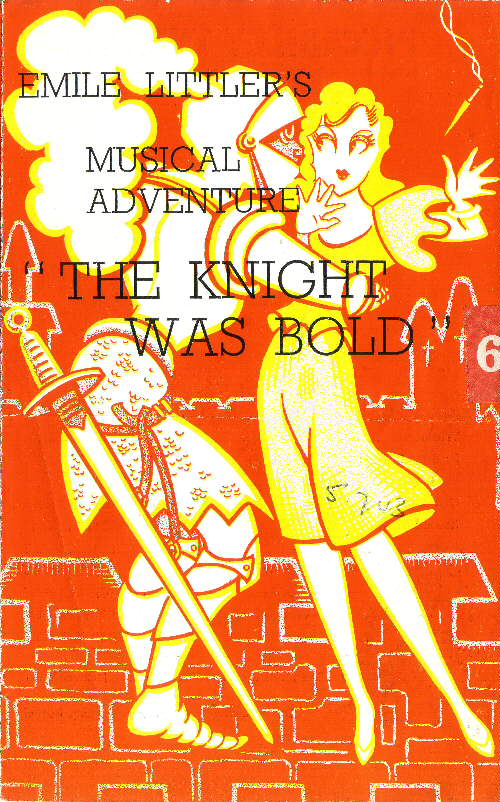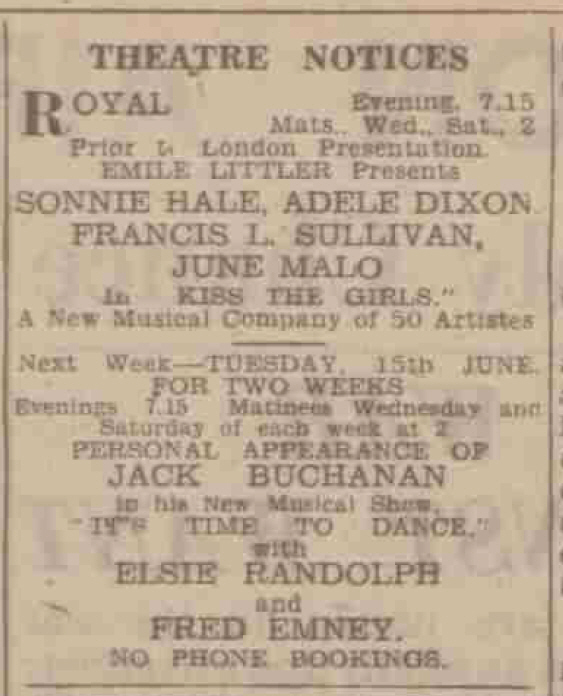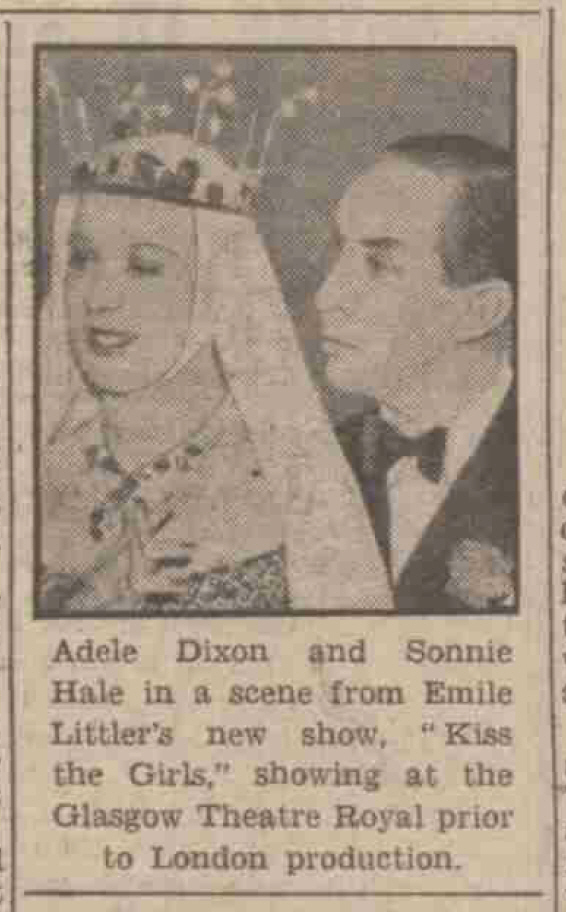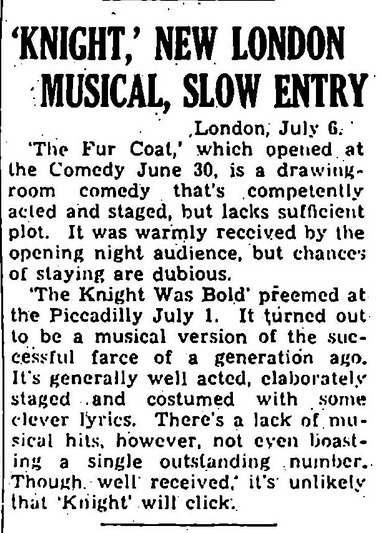|
Play List: 4. Corinne 7. The Mormons 9. Lucy Brandon 10. Storm-Beaten 11. Lady Clare 13. Bachelors 14. Constance 15. Lottie 16. Agnes 17. Alone in London 18. Sophia 19. Fascination 20. The Blue Bells of Scotland 21. Partners 24. Angelina! 25. The Old Home 26. A Man’s Shadow 27. Theodora 29. Clarissa 30. Miss Tomboy 32. Sweet Nancy 33. The English Rose 36. Marmion 37. The Gifted Lady 38. The Trumpet Call 39. Squire Kate 40. The White Rose 42. The Black Domino 44. The Charlatan 45. Dick Sheridan 47. Lady Gladys 48. The Strange Adventures of Miss Brown 49. The Romance of the Shopwalker 52. Two Little Maids from School ___ |
|
ROBERT WILLIAMS BUCHANAN (1841 - 1901) |
|
|
|
|
|
|
|
|
8. When Knights Were Bold - The Musical |
 |
|
The Stage (22 April, 1943 - p.4) “Kiss the Girls” On Monday, at the Royal, Newcastle-on-Tyne, Emile Littler will produce a musical comedy entitled, “Kiss the Girls,” with book by Harriett Jay, Emile Littler, and Thomas Browne; musical score by Harry Parr-Davies, and lyrics by Barbara Gordon and Basil Thomas./ In the cast will be Sonnie Hale, Adele Dixon, Francis Sullivan, June Malo, Guy le Feuvre, Con Kenna, Patrick Colbert, Gerhard Kempinski, April Rose, and Teddy Brogden. The dresses have been designed and made by Norman Hartnell, Doris Zinkelsen, and Physhe. The scenery is by Joseph Carl. The company will visit the Hippodrome, Coventry; Grand, Blackpool; Grand, Leeds; and Royal, Birmingham. The late Harriett Jay was the author of “When Knights were Bold.” ___
The Stage (6 May, 1943 - p.1) “KISS THE GIRLS” HIPPODROME, COVENTRY Coventry audiences this week are finding excellent entertainment in Emile Littler’s presentation of “Kiss the Girls,” which opened its tour at the Royal, Newcastle, on April 26. The musical comedy is founded upon “When Knights were Bold,” by Charles Marlowe, which was first produced at Wyndhams in 1907, and adheres to the original story. The book is by Harriett Jay (who as Charles Marlowe wrote the original comedy), Emile Littler, and Thos. Browne, and the musical score is by Harry Parr-Davies. The story opens in the baronial hall of Beechwood Castle. The guests are arriving for dinner prior to taking part in the annual regatta. Sir Brian Ballymote arrives with two American guests, Otis B. Lloyd and his daughter Dr. Sue Lloyd, who are anxious to buy the castle, which is already mortgaged up to the hilt. Dean Pottlebury, an uncle of Sir Guy de Vere, owner of the castle, also arrives with his eleven daughters, and is the prime mover in putting the curb on Sir Guy and his neglect of duty and irresponsible outlook on life. Rowena Brown, in love with Sir Guy, does all in her power to point out to Sir Guy his duty to his family name and tradition. Sir Guy, who left early to go on his first attempt at sailing, arrives wet through, after receiving a ducking, and Rowena orders him a hot whisky and a hot mustard bath in his room. Sir Guy then directs the servant to bring the hot mustard bath down to the hall, and after having had a few more drinks than are good for him, and toasting his armoured ancestors, he finally puts his feet in the hot mustard bath, falls asleep and dreams that he is living in the good old medieval days when knights were bold. ___
The Birmingham Post (25 May, 1943 - p.4) ENTERTAINMENTS THEATRE ROYAL At the Theatre Royal this week, Mr. Emile Littler has called in a thirty-five-year-old farce to pipe a merry modern tune. Presumably, as bait to the frivolous, he has called it “Kiss the Girls”; but beyond the fact that Sonnie Hale has a good song of this name early in the proceedings there is no apparent reason why this excellent adaptation of “When Knights Were Bold” should hide its brightly twinkling light under so trivial a title. Those who remember James Welch in the original production need not fear that violent hands have been laid on this near-classic of the early 1900’s. Mr. Littler, apparently, knows a good script when he sees it, and, wisely, has been content to let the original lines speak for themselves. The consequence is a centre-piece of substantial dialogue, with liberal lashings of music by Harry Parr-Davies. And very good music of its kind it is. The catchy tunes and lyrics slip easily into place without that jerky reluctance that attends the unsuitable song at the unsuitable moment. ___
Daily Record (Glasgow) (8 June, 1943 - pp.7,8) GLASGOW THEATRES Smart New Musical IF Glasgow’s advance approval is any criterion the new musical comedy, “Kiss the Girls,” is assured of success when it reaches London. |
 |
|||
 |
|||
|
There’s also a photo of Adele Dixon and Claud Allister in the roles of Rowena Brown and Wittle the butler, at Getty Images. ___
The Times (2 July, 1943 - p.6) PICCADILLY THEATRE “THE KNIGHT WAS BOLD” It would be wise not to bring to this musical version of When Knights Were Bold any hopes of knowing again the old helpless laughter of years ago. Decked out with a dozen dancers, the daughters of the Dean, and more than a dozen songs, of which “Whoopsy Diddly Dum de Dee” is incomparably the best, the fable is no longer capable of creating the cumulative fun of first-rate farce. But it makes a pleasant musical comedy. ___
Daily Express (2 July, 1943 - p.3) SONNIE HALE IN ARMOUR SAID perspiring Sonnie Hale, after appearing in “The Knight Was Bold,” at the Piccadilly Theatre last night, “If you want to take off a few pounds in weight, try playing my part for a night!” |
 |
|
[Advert for The Knight Was Bold from The Times (5 July, 1943 - p.8).] ___
Variety (7 July, 1943 - p.19) |
 |
|
The Stage (8 July, 1943 - p.4) THE PICCADILLY “THE KNIGHT WAS BOLD” On Thursday, July 1, Emile Littler presented here the musical piece by Harriett Jay, Emile Littler, and Thomas Browne, music by Harry Parr Davies, lyrics by Barbara Gordon and Basil Thomas, staged by Emile Littler and Maxwell Wray, dances devised and arranged by Philip Buchel, entitled “The Knight was Bold.” This “musical adventure” recalls some, though not all, of the happy memories associated with that thirty-six-year-old farce, “When Knights were Bold,” which brought such good fortune in turn to the late James Welch and Bromley Challoner, and gave such simple but genuine pleasure to large numbers of British playgoers. It is true that the central theme—the transference of modern people in a dream to ancient times—has lost a good deal of its freshness since the early years of the century. The films have frequently exploited it, and only recently the musical comedy, “Du Barry was a Lady,” found its inspiration in a flash-back to France in the days of the Grand Monarch. Still, the idea remains a good one, and “The Knight was Bold” is at its best when Sir Guy de Vere finds himself transported in slumber to medieval England when life generally made severe demands on the fortitude and endurance of men and women alike. In this piece, naturally, no one is expected to take these conditions seriously, and there is some genuine gaiety, as there was in the old farce, in the adventures of Sir Guy amongst his remote fourteenth century ancestors. “St. George for England,” sonorously declaims the Medieval Herald. To which the irreverent modern knight very naturally replies, “St. Pancras for Scotland.” Was this jest in the original? One forgets. Anyhow, it is a tolerable gag. So is Sir Guy’s description of the old drink, sack, as “gin and moat,” and there is an inevitable reference to “registering for the Crusades.” These lines can be quoted as fairly typical of the spirit in which the whole scene is contrived. _____
The musical version of When Knights Were Bold was not a success. According to the page on Harry Parr Davies on the Robert Farnon Society website: “In 1943 although The Knight was Bold had Sonnie Hale as the titled aristocrat dreaming he was back in the Middle Ages, after successfully touring the provinces under the title Kiss the Girls, it became a West End flop and left the Piccadilly Theatre after only 10 performances.” As well as writing several considerably more successful musicals, Harry Parr Davies also wrote songs for Gracie Fields (including “Sing As We Go” and “Wish Me Luck as you wave me goodbye”) and George Formby - so the man has a lot to answer for.
The Knight Was Bold - Programme _____
I also came across the following review of another musical version of the play from 1954:
The Guardian (23 December, 1954 - p.3) “WHEN KNIGHTS WERE BOLD”—TO MUSIC Manchester Playhouse Having already given us, in the recent season, a menu of good plays unusually well acted, the Salisbury Arts Theatre company at the Playhouse have given way to the heavy compulsion of the Christmas spirit with that hugely facetious old thing “When Knights Were Bold” by Charles Marlowe. It was first produced in 1906 and it combines those twin delights of that artistically sterile period, evening dress and medieval costume (Avaunt there, Sir Guy!)—into a mixture which has the sort of flavour of fizzy lemonade, certainly no stronger vintage. The company, with their usual versatility, manage the music and lyrics which they have added to it very well; they give it a choral harmony and a certain charm. They cannot do very much with the old-fashioned farce which includes too many weak-kneed verbal puns and rather a surfeit of comic business. Given a larger and more responsive audience than last night, they might warm it into life. But it is a good case in point for anyone who wants to question this Christmas convention. It is rather over the heads of the children, and a little too fizzy for those grown-ups who prefer the Playhouse’s higher quality theatre. _____
9. When Knights Were Bold - Miscellanea or back to When Knights Were Bold main menu
|
|
|
|
|
|
|